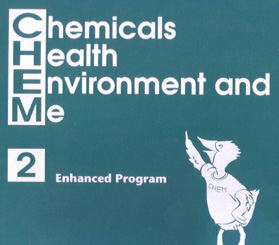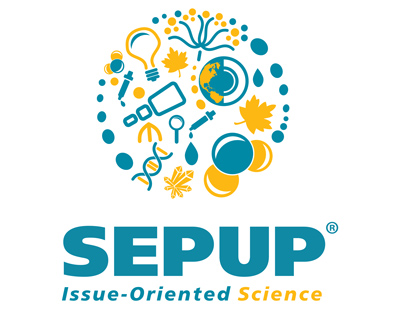Chemicals, Health, Environment and Me (CHEM2)

Chemicals, Health, Environment and Me (CHEM2)
Chemicals, Health, Environment and Me (CHEM2) is a supplementary science curriculum consisting of fifteen units. Each unit contains 3–5 activities, providing a total of approximately 15 weeks of science instruction. It is designed to help fourth, fifth, or sixth-graders learn:
- science concepts related to chemicals, health, and the environment.
- how to collect, process, and analyze information.
- how to use scientific evidence in decision-making.
Each of the fifteen units begins with a CHEM Dilemm, a cartoon-style drawing which engages students and allows them to express their preconceptions. Students then conduct a series of hands-on investigations using student pages and laboratory equipment. Student pages also include questions and reading.
Each CHEM-2 program includes:
- A Teacher’s Guide containing reproducible student pages
- A Kit containing the equipment required to conduct the activities with a class of 32 students.
The Teacher’s Guide provides specific strategies to facilitate discussion and assess student learning after each activity. It also includes materials to help teachers integrate science with other subjects in the elementary curriculum.
Sample Activity
Overview
CHEM-2 is a supplementary science curriculum consisting of fifteen units. Each unit contains 3–5 activities, providing a total of approximately 15 weeks of science instruction. It is designed to help fourth, fifth, or sixth-graders learn:
-science concepts related to chemicals, health, and the environment.
-how to collect, process, and analyze information.
-how to use scientific evidence in decision-making.
Each of the fifteen units begins with a CHEM Dilemm, a cartoon-style drawing which engages students and allows them to express their preconceptions. Students then conduct a series of hands-on investigations using student pages and laboratory equipment. Student pages also include questions and reading.
Each CHEM-2 program includes a Teacher’s Guide containing reproducible student pages and a kit containing the equipment required to conduct the activities with a class of 32 students. The Teacher’s Guide provides specific strategies to facilitate discussion and assess student learning after each activity. It also includes materials to help teachers integrate science with other subjects in the elementary curriculum.
Each of the 15 CHEM-2 units uses commonly available household and classroom supplies to bring laboratory experiences to fourth, fifth, and sixth-grade classrooms. Each activity focuses on a single concept.
Unit Descriptions
Everyday Chemicals
(recommended first activity)
Students make observations and describe properties of common substances. The description of physical properties of substances and the concept of a chemical reaction are introduced.
Build a Community
Students examine the essential services a community should provide as they explore the relationships and interactions between humans and their environment. In small groups, students design an ”ideal“ community and present their proposals to their classroom community members.
Sound
Students explore the cause of, and variables involved in, the production of sound. They learn about the difference between pitch and volume and about the vibrational (wave) nature of sound. Students also examine testimony in a mock jury trial as they try to determine fault in a case involving a person‘s hearing loss.
Energy to Go!
Students investigate electricity and magnetism as they make simple battery-powered electromagnets. They then explore trade-offs in the consumer use of different kinds of batteries and learn about the environmental effects of battery usage and disposal.
CHEM Chronicle
Students identify and explore how different media techniques are used for different purposes. Using media methods, they produce a class ”newspaper“ that summarizes their prior CHEM experiences. This newspaper can be used both as an indicator of what the class has learned and as a means of informing parents about classroom activities.
The Inside Story
Students are introduced to the idea that all foods are made up of chemicals. Food product labels are used to introduce and discuss food additives. Acid/base testing is used as one way of differentiating chemicals frequently used as food additives and in food preparation.
My Sweet Tooth
Students investigate the physical properties of sugar and sugar substitutes. They use a taste test to compare sugar and sugar substitutes and decide which they prefer. Other factors that influence a person‘s decision to use sugar or sugar substitutes are discussed. Ideas related to risk and decision making are introduced.
Mystery Spill
Students learn how qualitative tests are used to help identify chemicals. Using common household substances, a highway spill of potentially dangerous chemicals is simulated to reinforce the idea that we need to know what something is before we can deal with it properly. The standard highway placarding system for identifying chemical shipments is introduced, and students learn the symbols and their meaning by playing a game.
Hazardous Home
Students use pictures of different rooms to identify potentially hazardous chemicals found in the home. They are encouraged to work with their families to set up a home hazardous substance inventory program. Students complete a survey and extend it to adults in their community to investigate the recommended disposal procedures for various hazardous substances.
Trash or Cash?
Students collect, categorize, and measure the amount of trash they produce in a day at school. They use their estimate of the amount generated as an indicator of our society‘s waste disposal problem. Source reduction, recycling, and reuse are introduced as ways of reducing the amount of waste an individual produces.
What Is a Threshold?
Students use successive dilution of a sugar substitute to determine their threshold of taste. This experience is used to introduce the concept of a threshold. Definitions of “poison” and “toxic” are developed as the students are introduced to the role of thresholds in determining the toxic level of a substance.
Smoking and My Health
A smoking machine is used to model what actually happens when a person smokes a cigarette. Comparing a smoked cigarette filter to an unsmoked one introduces the harmful chemicals found in cigarettes. Students review and categorize cigarette advertisements to determine how cigarette companies use ads to encourage young people to smoke. The importance of obtaining and using information as part of a person‘s decision-making process is emphasized.
Carbon Dioxide and Me
Students observe the burning of a candle and use an indicator to determine that carbon dioxide is a product of burning and of their own respiration. Plant and animal roles in the carbon cycle are illustrated. Students investigate some of the properties of carbon dioxide by carrying out investigations and observing demonstrations by the teacher.
Pharmacology
Students examine historical and modern advertisements for medicines and explore the methods they use to appeal to consumers. Students learn about variables that affect dissolving rates as they investigate the design and function of some over-the-counter products. They also learn the importance of reading warning labels and following the instructions when taking any medication.
Good to the Last Drop
Students explore the cohesive property of water and learn to differentiate between solutions and mixtures. They then investigate and compare the processes of filtration and sedimentation for improving water quality. Students build a filtration device and design a model water treatment and filtration system for their community.

